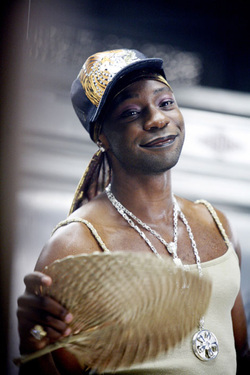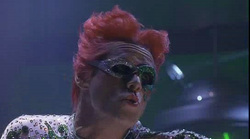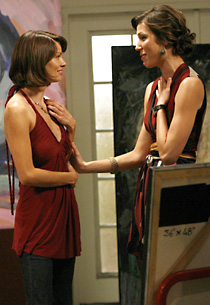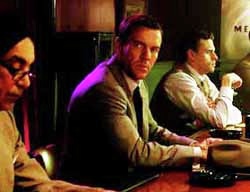Queer Theory
"The big lie about lesbians and gay men is that we do not exist" Vito Russo
Summary (Kristen Coleman & Becky Luksa):
In the broad sense, Queer Theory deals with the breaking of social norms. It focuses on the gap between the ideal, the normal, in society and the reality. It emphasizes, but is not necessarily confined to, dealing with the breaking of norms involved with sexuality, primarily because that is where the theory got its start. It also tries to find instances that may be considered "queer" that would have been ignored in past literary theories. It is the idea that gender does not define who one is or what they should be like. Terms such as "woman" or "man" are simply too general for a species that is so complex( theory.org).
History (Becky Luksa):
Gay history is a rather interesting one. It has been criminalized, made a sin, and somewhat accepted. Queer theory looks to examine these aspects of history and study how sexuality is received in society.
In many ancient cultures, homosexuality was a rather accepted part of society. But, in European cultures, it was considered to be a sin until the 1800s. At first, the crime of "sodomy" could be applied to just about anyone, but eventually came to be applied to just males( Critical Introduction pg 3). While the view of homosexuality has been different depending on the culture, in more modern times, it is usually something that is on the outside of society. Queer theory looks to examine this and see how it is defined in society.
Queer theory is a more recent form of literary theory. It began with the gay civil rights movement in the mid-part of the 20th century. Groups such as Mattachine Society worked to help incorporate homosexuality into the mainstream culture. They wanted to help assimilate gays into the "normal" aspects of everyday life (Critical Introduction pg 22). They would use the work of modern theorists saying that homosexuality is biologically determined and should not be punished by law (23). In the 1960s, there was a shift away from assimilation and a move towards political reform (29).
In many ancient cultures, homosexuality was a rather accepted part of society. But, in European cultures, it was considered to be a sin until the 1800s. At first, the crime of "sodomy" could be applied to just about anyone, but eventually came to be applied to just males( Critical Introduction pg 3). While the view of homosexuality has been different depending on the culture, in more modern times, it is usually something that is on the outside of society. Queer theory looks to examine this and see how it is defined in society.
Queer theory is a more recent form of literary theory. It began with the gay civil rights movement in the mid-part of the 20th century. Groups such as Mattachine Society worked to help incorporate homosexuality into the mainstream culture. They wanted to help assimilate gays into the "normal" aspects of everyday life (Critical Introduction pg 22). They would use the work of modern theorists saying that homosexuality is biologically determined and should not be punished by law (23). In the 1960s, there was a shift away from assimilation and a move towards political reform (29).
Important People (Becky Luksa):
Judith Butler: Author of the book Gender Trouble. She is a professor of Literature and Rhetoric at the University of California and is a known theorist on the subjects of power, gender, and sexuality. Instead of the idea the sex causes gender and that gender causes desire, she believes that gender and desire and more interchangeable and can change because of a variety of factors and time (theory.org).
Micheal Focault: 20th century French professor and philosopher. Many of his works such as, The History of Sexuality, focuses on sexuality in the terms of society. He believed that the modern ideas and knowledge about sexuality ("sciences of sexuality") are directly connected with modern constructs of society (Gutting par. 22). According to Focault, societal norms are internalized in individuals, and those individuals try to keep themselves in check with those social norms( Gutting par. 23).
Micheal Focault: 20th century French professor and philosopher. Many of his works such as, The History of Sexuality, focuses on sexuality in the terms of society. He believed that the modern ideas and knowledge about sexuality ("sciences of sexuality") are directly connected with modern constructs of society (Gutting par. 22). According to Focault, societal norms are internalized in individuals, and those individuals try to keep themselves in check with those social norms( Gutting par. 23).
Queer Theory in Pop Culture (Kristen Coleman):

Queering of Characters: This approach to Queer Theory was outlined in A Critical Introduction to Queer Theory, and basically comes down to, as was stated rather humorously in it, "spot the queer." This approach is used often in non-academic contexts as much as academic ones, particularly among devoted fan-bases of various movies, books and TV shows. Examples of this include Harry Potter, Batman, Star Trek, Sherlock Holmes, and Xena.
Fanfiction (which are stories written by fans using the characters and world of a book, movie, show, etc.) offers a way to actually quantify how widespread this queering of characters is among these devoted fan-bases. On fanfiction.net, the largest fanfiction site on the web, there are 482,475 total Harry Potter fanfiction. 27,398 of them are under the romance, and Harry and Draco setting. As a comparison, Ginny and Harry, also under the romance setting, only have 13,348, and Hermione and Ron do slightly better at 15,257. Harry and Hermione are between them at 14,762 (Data taken on 11/6/10).
Fanfiction (which are stories written by fans using the characters and world of a book, movie, show, etc.) offers a way to actually quantify how widespread this queering of characters is among these devoted fan-bases. On fanfiction.net, the largest fanfiction site on the web, there are 482,475 total Harry Potter fanfiction. 27,398 of them are under the romance, and Harry and Draco setting. As a comparison, Ginny and Harry, also under the romance setting, only have 13,348, and Hermione and Ron do slightly better at 15,257. Harry and Hermione are between them at 14,762 (Data taken on 11/6/10).
Batman and Robin are another two characters with a history of queering. It was even discussed in A Critical Introduction to Queer Theory. In it an article and a text are mentioned. The article is "Holy Homosexuality Batman!: Camp and Corporate Capitalism in Batman Forever" and the text Seduction of the Innocent. Both, apparently have "spotted the queer" in Batman, although as is pointed out, it isn't hard to see the Riddler's queer in Batman Forever when you're presented with this visual. (195)
Within fan-bases this queering is generally referred to as slash or slashing (generally characters who are being paired romantically are written with a slash between their names, such as Kirk/Spock). This began with Kirk/Spock from Star Trek's Original Series. In a very impressive example of compiling evidence (if in a humorous and informal fashion) to try to prove that the interpretation of Kirk and Spock loving each other as more than friends is valid and fully supported by the show (and the movies), is a Star Trek fan who goes by the name of Brittany Diamond. Her AnalyzationCommentary of TOS for K/S is going through each and every episode and movies, essentially line by line in a methodology reminiscent of the close readings we have done in class, and pointing out moments that indicate a closer relationship between Captain Kirk and Commander Spock than just friendship, as well as poking fun, in a loving way, at the absurd special effects. Her thesis statement, as it were, is, "I say that Kirk and Spock had NUMEROUS moments of flirting and all out tension of both a ROMANTIC and SEXUAL nature. And it's not just in between the lines with subtext and telling looks, it's right there in the TEXT itself. It's canon. As I will explain," (Ch.1).
She has currently finished 41 chapters, and it is 271,434 words long. She also has a show on YouTube called The Ship's Closet which is essentially a condensed version of much of the evidence she presents in AnalyzationCommentary,
She has currently finished 41 chapters, and it is 271,434 words long. She also has a show on YouTube called The Ship's Closet which is essentially a condensed version of much of the evidence she presents in AnalyzationCommentary,
Of course, there is academic work as well as non-academic which centers on Kirk/Spock slash. P.J. Falzone's The Final Frontier is Queer: Aberrancy, Archetype and Audience Generated Folklore in K/S Slashfiction appeared in Western Folklore, and comes to some interesting conclusions about not only the pairing, but those writing it. The article concludes that,
This paper argues that what the characters of Kirk and Spock represent is an archetypal pairing that transcends gender altogether. By reading K/S queerly and broadly, these gender distinctions become irrelevant. What matters are the characters themselves, and the unique qualities that make fan authors--straight, gay, indifferent--feel the need to pair them.
Specifically, the Kirk/Spock pairing represents not a bonded pair, but a divided self. Sexuality, like the mindmeld, becomes a stand-in for the reunification spoken of in Aristophanes' tale of the Children of the Sun--two humans once whole separated and ever seeking their other half. The corporate caretakers of these characters have proven themselves, to a broad readership, unwilling to realize the "particular style of the 23rd century" as one in which queer love is acceptable love. And so, for close to forty years, an active and activist readership has been doing it for them through the creation of an aberrant folklore that they believe adheres more closely to the spirit of the narrative's utopian origins. It has fallen upon the fan to become creator, the reader to become the author, and the author to become active in the reuniting of this divided self (20).
The quote about the "particular style of the 23rd century" comes from Gene Roddenberry, the creator of Star Trek. It was stated in an interview in response to a question about the comparison of Kirk and Spock to Alexander the Great and Hephaestion that appeared in an authorized William Shatner biography called Shatner: Where no man... and is frequently quoted by slash fans. The full quote is, "Yes, there's certainly some of that – certainly with love overtones. Deep love. The only difference being, the Greek ideal – we never suggested in the series – physical love between the two. But it's the – we certainly had the feeling that the affection was sufficient for that, if that were the particular style of the 23rd century," (Memory Alpha).
On Fanfiction.net, there are 3,377 Star Trek: TOS fics, 1,006 of them are under the romantic category, and 320 of those are under the Kirk and Spock category. In other words, about 32% of them are Kirk/Spock. In the Star Trek: 2009 movie section there are 6,285 fics, 3,169 are in the romance category, and 1,039 are in the Kirk and Spock categories--about 33% (11/6/10).
There is an archive completely devoted to Kirk/Spock fanfiction called the Kirk/Spock Fanfiction Archive that has 2,048 stories (11/9/10), and a forum called SEE (Social Equality Effort) Trek Love that is devoted to trying to get gay characters into official Star Trek media.
This paper argues that what the characters of Kirk and Spock represent is an archetypal pairing that transcends gender altogether. By reading K/S queerly and broadly, these gender distinctions become irrelevant. What matters are the characters themselves, and the unique qualities that make fan authors--straight, gay, indifferent--feel the need to pair them.
Specifically, the Kirk/Spock pairing represents not a bonded pair, but a divided self. Sexuality, like the mindmeld, becomes a stand-in for the reunification spoken of in Aristophanes' tale of the Children of the Sun--two humans once whole separated and ever seeking their other half. The corporate caretakers of these characters have proven themselves, to a broad readership, unwilling to realize the "particular style of the 23rd century" as one in which queer love is acceptable love. And so, for close to forty years, an active and activist readership has been doing it for them through the creation of an aberrant folklore that they believe adheres more closely to the spirit of the narrative's utopian origins. It has fallen upon the fan to become creator, the reader to become the author, and the author to become active in the reuniting of this divided self (20).
The quote about the "particular style of the 23rd century" comes from Gene Roddenberry, the creator of Star Trek. It was stated in an interview in response to a question about the comparison of Kirk and Spock to Alexander the Great and Hephaestion that appeared in an authorized William Shatner biography called Shatner: Where no man... and is frequently quoted by slash fans. The full quote is, "Yes, there's certainly some of that – certainly with love overtones. Deep love. The only difference being, the Greek ideal – we never suggested in the series – physical love between the two. But it's the – we certainly had the feeling that the affection was sufficient for that, if that were the particular style of the 23rd century," (Memory Alpha).
On Fanfiction.net, there are 3,377 Star Trek: TOS fics, 1,006 of them are under the romantic category, and 320 of those are under the Kirk and Spock category. In other words, about 32% of them are Kirk/Spock. In the Star Trek: 2009 movie section there are 6,285 fics, 3,169 are in the romance category, and 1,039 are in the Kirk and Spock categories--about 33% (11/6/10).
There is an archive completely devoted to Kirk/Spock fanfiction called the Kirk/Spock Fanfiction Archive that has 2,048 stories (11/9/10), and a forum called SEE (Social Equality Effort) Trek Love that is devoted to trying to get gay characters into official Star Trek media.
Another two that are often queered, or slashed, are Sherlock Holmes and John Watson, generally based on their close friendship, and the fact that Sherlock constantly interferes with Watson's love life, which is then interpreted as jealousy. In fact, in a recent three part mini-series that aired on the BBC, they bring this up, as a humorous moment, in the first episode, A Study In Pink.
Xena's relationship with Gabrielle was, when the show aired and even afterward, hotly debated within the fandom. However, they are considered often to be an iconic lesbian couple even if it never quite crossed the line into being explicitly a relationship during the show.
Dealing with the Queer:

Then there are the shows, movies, and books where the Queer is completely out in the open, and then deal with the reactions of that broken norm. This also then deals with depictions of gays and lesbians, and both queening and butch/femme dynamic, both of which were discussed in A Critical Introduction to Queer Theory.
Lafayette from the show True Blood is a very current example of a "queen" in a TV show who manages to have a depth of characterization that being a "queen" is only the surface of. He both embodies the stereotype, and breaks it by showing that he has more to him than that. One of the pivotal moments in the show where this occurs is when he is held in captivity by the vampire sheriff Eric, where his "queen" is drastically lessened. This occurs at the end of season one and throughout season two.
True Blood also deals with Queer Theory in a more broad sense with Sookie and Bill's relationship, and the various reactions the people of Bon Temps have to a vampire and a human being in a relationship. You can also make the, perhaps somewhat tenuous, parallel between what they face and what LGBT people have to face, particularly when phrases like "coming out of the coffin" are used.
In terms of the Butch/Femme dynamic, Xena and Gabrielle probably the best example of it. They both are fighters, but Gabrielle is consistently shown as more feminine. She is Xena's support, and Xena is the butch of the relationship.
Bones is a show that has deliberately avoided the Butch/Femme characterization. In season four, Angela's ex-girlfriend Roxie is introduced, beginning in episode 8, The Skull in the Sculpture, and the two resume a relationship until episode 17 of the same season, The Salt in the Wounds. They are both portrayed very much in line with the Femme part of the Butch/Femme dynamic, and therefore break that mold.
Lafayette from the show True Blood is a very current example of a "queen" in a TV show who manages to have a depth of characterization that being a "queen" is only the surface of. He both embodies the stereotype, and breaks it by showing that he has more to him than that. One of the pivotal moments in the show where this occurs is when he is held in captivity by the vampire sheriff Eric, where his "queen" is drastically lessened. This occurs at the end of season one and throughout season two.
True Blood also deals with Queer Theory in a more broad sense with Sookie and Bill's relationship, and the various reactions the people of Bon Temps have to a vampire and a human being in a relationship. You can also make the, perhaps somewhat tenuous, parallel between what they face and what LGBT people have to face, particularly when phrases like "coming out of the coffin" are used.
In terms of the Butch/Femme dynamic, Xena and Gabrielle probably the best example of it. They both are fighters, but Gabrielle is consistently shown as more feminine. She is Xena's support, and Xena is the butch of the relationship.
Bones is a show that has deliberately avoided the Butch/Femme characterization. In season four, Angela's ex-girlfriend Roxie is introduced, beginning in episode 8, The Skull in the Sculpture, and the two resume a relationship until episode 17 of the same season, The Salt in the Wounds. They are both portrayed very much in line with the Femme part of the Butch/Femme dynamic, and therefore break that mold.
Web Sites (Becky Luksa & Kristen Coleman):
http://www.queertheory.com/queer_theory_site_index.htm
http://www.theory.org.uk/ctr-quee.htm
For Fanfiction, Kirk/Spock, and Xena info:
http://en.wikipedia.org/wiki/Fan_fiction
http://en.wikipedia.org/wiki/Kirk/Spock
http://en.wikipedia.org/wiki/Xena:_Warrior_Princess
For Actual Fanfiction:
Fanfiction.net: http://www.fanfiction.net/
Kirk/Spock fanfiction: http://www.ksarchive.com/index.php
AnalyzationCommentary of TOS for K/S:
http://www.fanfiction.net/s/5105759/1/AnalyzationCommentary_of_TOS_for_KS
For Info on Star Trek and True Blood:
Memory Alpha: http://memory-alpha.org/wiki/Portal:Main
True Blood: http://truebloodwiki.hbo.com/
SEE Trek Love:
http://www.seetreklove.com/forums/index.php
http://www.theory.org.uk/ctr-quee.htm
For Fanfiction, Kirk/Spock, and Xena info:
http://en.wikipedia.org/wiki/Fan_fiction
http://en.wikipedia.org/wiki/Kirk/Spock
http://en.wikipedia.org/wiki/Xena:_Warrior_Princess
For Actual Fanfiction:
Fanfiction.net: http://www.fanfiction.net/
Kirk/Spock fanfiction: http://www.ksarchive.com/index.php
AnalyzationCommentary of TOS for K/S:
http://www.fanfiction.net/s/5105759/1/AnalyzationCommentary_of_TOS_for_KS
For Info on Star Trek and True Blood:
Memory Alpha: http://memory-alpha.org/wiki/Portal:Main
True Blood: http://truebloodwiki.hbo.com/
SEE Trek Love:
http://www.seetreklove.com/forums/index.php
Movies (Becky Luksa):
Far From Heaven: This movie has various elements that lend themseleves to Queer Theory. Not only is there the male relationship between the male lead (Dennis Qauid). But there is also the relationship between the wife and their black gardener. While the two never actually have an affair, it is assumed when the two are seen together in a black part of town. But when her husband hears the rumor about the affair, he seems to be more upset about the fact that it is ruining the image that they have worked so hard to create, instead of the possibility that his wife is cheating on him. One of the more interesting elements is when the wife finally confides in her friend about her husband being gay. Her friend is rather accepting of the husband being gay, but can not take it when the possibility of her white friend being in love with a white man. The movie shows how both types of relationships were controversial in that time, and still are today.
M.Butterfly: This movie is based off of the original play. It is the story of a man from Paris who falls in love with a Chinese women. But, this woman is in fact a man who is a Chinese spy. While the movie and the play both deal with various cultural themes, the idea of being gay is played around with. It can be argued that the main character of the movie still loves his former companion even though it is revealed that he is a man. This is partly because during the play/movie, there is some indication that the main character knows the true identity of his "love." This movie also deals with the idea of what exactly sexuality is and how it is translated into society as far was what is accepted.
:
M.Butterfly: This movie is based off of the original play. It is the story of a man from Paris who falls in love with a Chinese women. But, this woman is in fact a man who is a Chinese spy. While the movie and the play both deal with various cultural themes, the idea of being gay is played around with. It can be argued that the main character of the movie still loves his former companion even though it is revealed that he is a man. This is partly because during the play/movie, there is some indication that the main character knows the true identity of his "love." This movie also deals with the idea of what exactly sexuality is and how it is translated into society as far was what is accepted.
:




